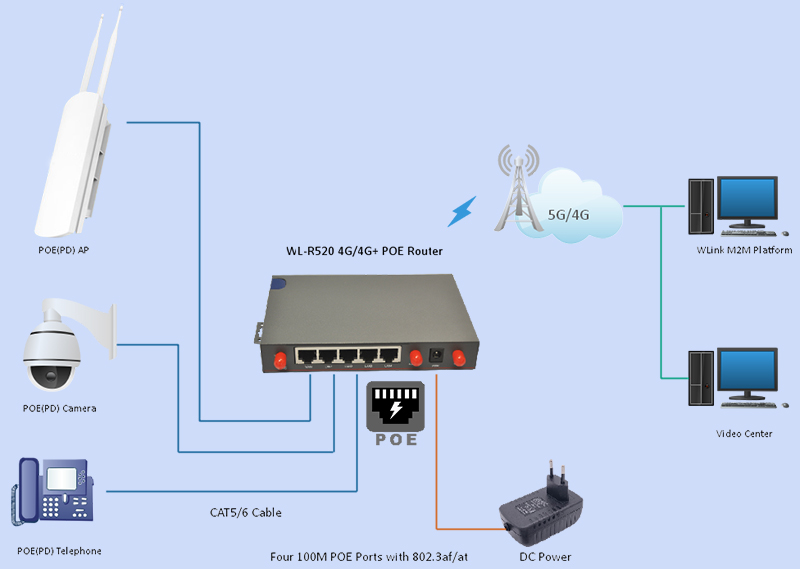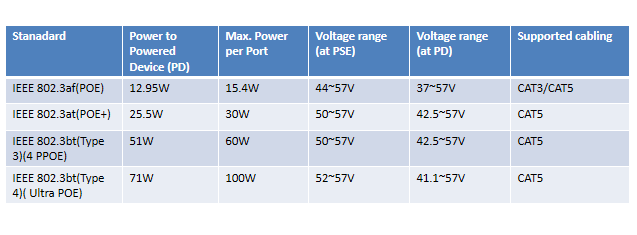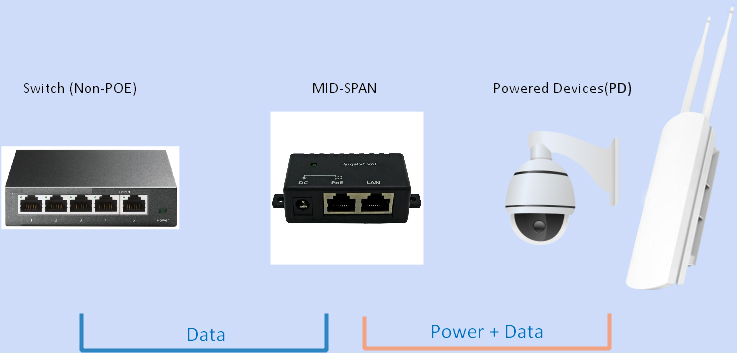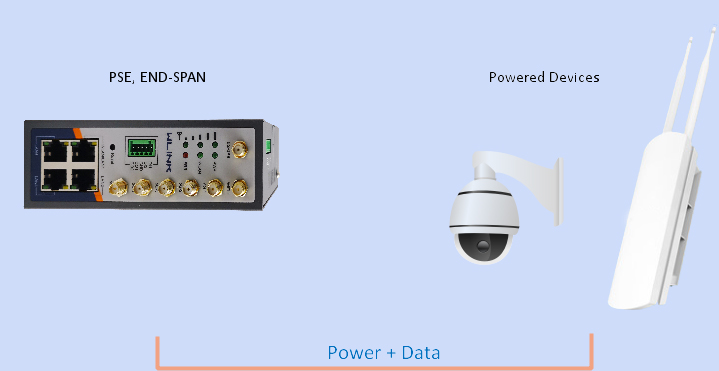
HOME < Technology < Power over Ethernet (PoE)
Standard PoE can be added on Wlink G530 5G Router and G520 4G Router , what is PoE and how it works in Wlink router with other terminal device to satisfy the project's demand?
What is Power over Ethernet?
Power over Ethernet (PoE) is a standard that allows Ethernet cables to transmit data and power simultaneously using a single network cable. It enables one RJ45 cable to provide both data connection and electric power to PDs instead of having a separate cable for each. PoE-capable devices can be power sourcing equipment (PSE), powered devices (PDs), or sometimes both. The device that transmits power is the PSE, while the device that is powered is a PD.

Standard and Terminology
The original IEEE 802.3af-2003 PoE standard provides up to 15.4 W of DC power (minimum 44 V DC and 350 mA) on each port. Only 12.95 W is assured to be available at the powered device as some power dissipates in the cable. The updated IEEE 802.3at-2009 PoE standard also known as PoE+ or PoE plus, provides up to 25.5 W of power for Type 2 devices.
The IEEE 802.3bt-2018 standard further expands the power capabilities of 802.3at. It is also known as PoE++ or 4PPoE. The standard introduces two additional power types: up to 51 W delivered power (Type 3) and up to 71.3 W delivered power (Type 4). Each pair of twisted pairs needs to handle a current of up to 600 mA (Type 3) or 960 mA (Type 4).

1) Power Sourcing Equipment
Power sourcing equipment (PSE) are devices that provide (source) power on the Ethernet cable. This device may be a network switch, commonly called an end-span (IEEE 802.3af refers to it as endpoint), or an intermediary device between a non-PoE-capable switch and a PoE device, an external PoE injector, called a midspan device.
2) Powered Device
A powered device (PD) is any device powered by PoE, thus consuming energy. Examples include wireless access points, VoIP phones, and IP cameras. Furth more, many powered devices have an auxiliary power connector for an optional external power supply. Depending on the design, some, none, or all the devices’ power can be supplied from the auxiliary port, with the auxiliary port also sometimes acting as backup power in case PoE-supplied power fails.
POE Modes and Power Types
1) MID-SPAN
If a non-PoE-enabled network switch is to be used with a PoE device, a power source that adds power to the connection is required. This device is placed between ("in the middle") the non-PoE network switch and the PoE device. A very common type of a PoE midspan is a PoE injector.

2) END-SPAN
Also called endpoint, the typical end-span is a PoE Network Switch. Since the switch itself can power connected devices, there is no need for an additional power source between the PoE switch (PSE) and the connected PoE edge device (PD).

PoE Working Process
When the PSE power supply end device is deployed in a network, the Power over Ethernet working process is as follows:
1) Detection
At the beginning, PSE device outputs a small voltage until it detects that the other end of the cable is a powered device that supports the POE standard.
2)Classification of Powered Device
After detecting the powered device, the PSE device may classify it and evaluate the power it requires.
3)Start Power Supply
In a configurable start-up period (generally within 15μs), the PSE device begins to supply power to the PD from a low voltage to 48V DC.
4)Continuous Power Supply
Provide stable and reliable 48V DC power for PD, and the power consumption does not exceed 15.4W.
5)Power Off
When the PD is disconnected from the network, the PSE will quickly (usually within 300-400ms) stop power supply, and repeat the detection process to see if there's still a PD.
PoE Advantages
Safety
PoE delivery is intelligent, and designed to protect network equipment from overload, under powering, or incorrect installation.
Reliability
PoE power comes from a central and universally compatible source, rather than a collection of distributed wall adapters. It can be backed-up by an uninterruptible power supply, or controlled to easily disable or reset devices.
Flexibility
Without being tethered to an electrical outlet, devices such as IP cameras and wireless access points can be located wherever they are needed most, and repositioned easily if required.
Scalability
Having power available on the network means that installation and distribution of network connections is simple and effective.
Time and Cost Savings
By reducing the time and expense of having electrical power cabling installed. Network cables do not require a qualified electrician to fit them, and can be located anywhere.
-- The end











